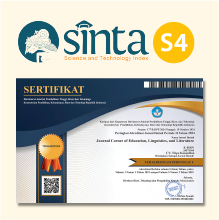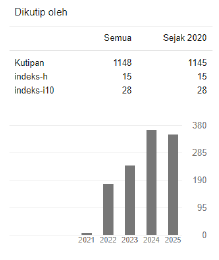Between the Languages: Delineating the Motives and Attitudes of Language Learners Towards Code-Switching
 https://doi.org/10.54012/jcell.v3i4.279
https://doi.org/10.54012/jcell.v3i4.279
 Abstract views: 1162
Abstract views: 1162
 PDF downloads: 437
PDF downloads: 437
Keywords:
Code switching, motives, attitudes, phenomenology, PhilippinesAbstract
This study was conducted to analyze the motives and attitudes of students towards code switching. This study employed a qualitative phenomenology research design. According to the findings, the students revealed that they encountered different challenges in terms of their teaching and learning especially in speaking correctly without any error because of the rules and other things they must follow as well as to consider during the making of sentences. The speaking skill of the students will never be as constant because language is not only dynamic but also code-switching can be more expressive and active to express themselves and share their thoughts much easier. Furthermore, code-switching alternates between the speakers’ native language and the second language which they aim to acquire. It is said that English should be used to increase the input and output of the target language and that the L1 should be avoided. Therefore, nowadays, people are bilinguals and they spoke language to which they are comfortable. Data suggest that codeswitching can help with language fluency by keeping both languages active and accessible, and therefore providing an alternative means of communicating meaning.
Downloads
References
Alenezi, A. (2010). The effect of Code Switching on learners’ learning experience in the collage of health: An exploratory study.
Asali, S. (2011). Attitudes of Arab American Speakers in the USA towards English-Arabic Code-switching. Middle East University. Amman,Jordan.
Baker, C. (2011). Foundations of bilingual education and bilingualism (Vol. 79). Multilingual matters.
Baquerfo, (2012). Exploring the Viewpoints and Motives of Students on Code Switching in the Classroom.
Bilgin, G. P., & Rahimi, A. (2013). EFL Teachers’ Attitude toward Code Switching: A Turkish Setting. International Journal of Linguistics.
Bista, K. (2010). Factors of Code Switching among Bilingual English Students in the University Classroom: A Survey. Online Submission, 9(29), 1-19.
Clegg, J. & Afitska, O. (2011). “Teaching and learning in two languages in African Classroom.” Comparative Education, 47(1).pp.61-77.
Eldin, A. A. T. S. (2014). Socio Linguistic Study of Code Switching of the Arabic Language Speakers on Social Networking. International Journal of English Linguistics.
Fishman, Joshua (1967). "Bilingualism with and without diglossia; Diglossia with and without bilingualism". Journal of Social Issues. 23 (2): 29–38.
Hall & Cook, (2012). Teacher’s Code Switching in EFL Undergraduate Classrooms in Libya: Functions and Perceptions.
Jdetawy, L. F. A. (2011). Arabic-English Code-Switching among Arab Students at
UUM, Malaysia. Language in India, 11(5).
Jingxia, Liu, (2010). Teachers’ code-switching to the L1 in the EFL classroom. The Open Applied Linguistics Journal, (3):10-23.
Lee, H. L. J., (2010). Code switching in the Teaching of English as a second language to secondary school students. Malaysian Journal of ELT Research, 6, 1-45.
Macaro, (2014). Teachers’ code-switching in (ESL) instruction: Perceptions of selected secondary school learners in Zimbabwe
Matthews, B. & Ross, L. (2010). Research methods. New York: Pearson Longman.
Moduopela, O.R. (2013). “Code-switching as a teaching strategy: Implications for English Language teaching and learning in a multilingual society. ‟
Momenian, M., & Samar, R. G. (2011). Functions of code-switching among Iranian advanced and elementary teachers and students. Educational Research and Reviews.
Nerghes, A. (2011). The Impact of Code-Switching on Persuasion: An Elaboration Likelihood Perspective. Wageningen University.
Probyn, (2010). Filipino-English Code Switching Attitudes and Practices and Their Relationship to English Academic Performance among Freshman Students of Quirino State University.
Rahimi, A., & Jafari, Z., (2011). Iranian Students’ Attitudes toward the Facilitative and Debilitative Role of Code-switching; Types and Moments of Code-switching at EFL Classroom. The Buckingham Journal of Language and Linguistics.
Sampson, A., (2011). Learners’ code-switching versus English only. ELT Journal.
Simasiku, L. (2014). The perceptions of Grade 10 English Second Language teachers about the effects of code switching in their classrooms in the Caprivi Education Region. PhD Thesis. Windhoek: UNAM.
Song & Andrews, (2009). The L1 in L2 learning: Teachers’ beliefs and practices. München: LINCOM.
Sreehali, P. (2012). Communicative Language Teaching: Possible and Problems. English Language Teaching.
Taweel, A. and Batoosh, M. (2012). Syntactic aspects of Jordanian Arabic- English intra-sentential code switching. (Unpublished thesis), Al Hussein BinTalal University. Amman: Jordan.
Valdez, (2010). Sun.Star Pampanga: 2018-05-15-A Switching to Code Retrieve May 29, 2021 from http://www.pressreader.com/philippines/sunstar- pampanga/20180515
Downloads
Published
How to Cite
Issue
Section
License
Copyright (c) 2024 Pedro P. Raymunde Jr

This work is licensed under a Creative Commons Attribution-ShareAlike 4.0 International License.
All articles published in the Journal Corner of Education, Linguistics, and Literature are licensed under the Creative Commons Attribution-ShareAlike License (CC BY-SA).

















